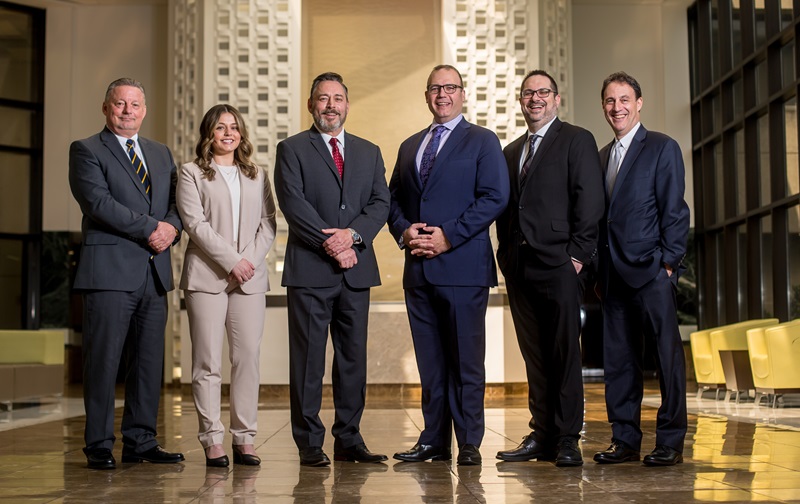From left: Scarinci Hollenbeck LLC’s growing commercial real estate team includes Michael Jedziniak, Kaylin Olsen, Donald Pepe, Robert L. Baker Jr., Michael Willner and Matthew Kane. — Photos by Aaron Houston for Real Estate NJ
By Joshua Burd
It’s one thing to become the proverbial one-stop shop, as Scarinci Hollenbeck LLC has sought to do with a series of recent additions to its real estate department. But the Little Falls-based law firm has also keyed on what it sees as important growth areas in the space.
That strategy is now taking shape at Scarinci, whose long-established real estate team has grown to 15 full-time attorneys from nine last summer, adding new expertise in everything from affordable housing and litigation to foreclosures and landlord-tenant disputes in the wake of the pandemic.

“It’s a focused expansion,” said Donald Pepe, a partner and chair of the firm’s commercial real estate practice. “We went out and we expressly looked for people who can provide the types of services that we’re observing that the clients need more and more.”
That means differentiating Scarinci Hollenbeck from “generalized real estate groups where attorneys … will venture into areas that they might be reasonably competent in, but it’s not their specialty,” Pepe added. It’s also meant to create confidence that the firm can truly deliver for real estate clients that are increasingly seeking a full-service option, one that will draw on its robust environmental practice and its existing bench of real estate lawyers.
“I think we’ve created the comfort zone by offering all of these otherwise niche practice areas in one team, not just one law firm,” said Donald Scarinci, the firm’s managing partner. “Law firms are not necessarily teams. What we’ve done is we’ve created a team to handle complex real estate real estate projects, so there’s a coordinated approach, which ends up being cost-effective to the client and a lot easier for the client to manage.”

One of the team’s newest additions, Michael Jedziniak, arrived Jan. 15 with nearly 25 years of experience in the complex, often contentious world of litigation tied to local affordable housing obligations in New Jersey. He expects that practice to remain highly active after a law signed by Gov. Phil Murphy in March, which sets a course for a new round of municipal requirements under the guidance of the state’s Department of Community Affairs.
By his count, some 350 towns and cities in New Jersey “are going to be gearing up and trying to figure out what their numbers are going to be” in the years to come. Jedziniak, a counsel with Scarinci’s commercial real estate group, noted that he has been advising municipal clients “that we need to take action proactively so we’re not playing catch-up later on in the year.”

He added that he has represented some 60 municipalities in affordable housing cases during his career but is now shifting his focus to representing developers.
“It’s an administrative maze — you’re mixing politics, land use law, redevelopment and Mount Laurel principles,” Jedziniak said, referring to the landmark state Supreme Court cases that have guided affordable housing policy since the 1970s. “And it’s a very complex area of the law.”
Another source of growth will likely come from clients such as direct lenders, servicing companies and hedge funds that have acquired properties through foreclosure and are attempting to vacate those buildings before selling them. Matthew Kane, who joined Scarinci in 2017, is spearheading that effort and noted that foreclosures and evictions were halted during the COVID-19 crisis, creating a logjam for owners that’s now breaking.

“There’s a huge backlog of foreclosures in New Jersey and New York — evictions as well — so the clients are in the process of trying to figure out how to get that logjam through to conclusion,” said Kane, a partner with Scarinci. “So that’s really the overriding theme and issue that I’m dealing with right now — trying to help them get to the point where they conclude the foreclosure or the workout situation with the borrowers that went into default.”
He added that clients are also in catch-up mode after having to lay off large numbers of employees during the pandemic, “so some of this is just a matter of not having enough hands to process the work.” Many are now “trying to retool and hire people back to push the work through.”
That dovetails with the role of Kaylin Olsen, who joined the firm as an associate late last year and primarily represents multifamily and commercial owners in nonpayment of rent or eviction cases. She noted that the courts have largely worked off the COVID backlog, meaning landlords can typically have their cases heard within three weeks of filing a complaint.

“That’s been great for the client to get their cases heard and handled within about a month or so timeframe, compared to before, where it would take six to eight months just to get one tenant evicted,” said Olsen. She added that resolutions are “happening sooner rather than later,” while there is a more consistent pace of cases that are filed and heard by judges each month.
The team’s newest recruit, Michael Willner, has bolstered Scarinci’s ability to handle real estate-related litigation. That’s evident in areas such as condominium associations or cooperatives, for instance, where a board or a managing agent has “exceeded their authority to the point where they’ve curtailed the rights of various unit owners.” In some cases, he said, he is “advising boards that they have to exercise more restraint in what they’re doing,” while also representing unit owners that are seeking relief against boards that have overstepped.

As for what’s creating an uptick in such cases, Willner said “it’s a myriad of factors,” from board members who feel overly empowered to those that passed a rule during the pandemic that “was contrary to the bylaws or contrary to the declaration or the master deed.”
Robert Baker, who joined the firm in February, also sees continued demand as a lawyer who focuses largely on commercial leasing. The industrial sector remains robust, he said, although owners are now grappling with tenants that feel sticker shock at renewal time.
“A lot of these leases are aged at this point,” said Baker, a partner, noting that many were executed eight to 10 years ago. That has complicated negotiations and even created holdover situations as landlords seek fair market value in an asset class that has surged over the past decade.

“I guess it’s a good problem to have, if you will, but it causes potential litigation, baseball arbitration provisions and protracted negotiations for these valuations,” Baker added.
The activity comes as Scarinci Hollenbeck builds on what have been the cornerstones of its commercial real estate practice. Land use remains robust, Pepe said, citing the team’s continued role in projects along New Jersey’s Gold Coast. He’s also working on redevelopment plans for both the former Echelon Mall property in Voorhees and Flemington’s Liberty Village, building on the firm’s work with the Monmouth Mall in Eatontown.
“There’s a good opportunity there because these malls represent a significant portion of the tax ratable base for various municipalities, so the municipalities have a real incentive to make sure that something positive happens with the property,” Pepe said. “And, of course, when you’re representing the developers, that’s their goal as well. So we find a little bit of symmetry between the municipalities and the developers, which is not always the case.”
The projects will likely benefit from the firm’s growing resources in affordable housing, real estate litigation and other niche areas, with recent additions to the department also including Doug Ehrenworth and Daniella Dalia as partner and of counsel, respectively. The same is true for transactions and projects by future clients that Scarinci Hollenbeck hopes to attract with its full-service team.
“There are new players post-pandemic, and those players are looking for a home,” Scarinci said. He pointed, for instance, to New York developers that face new regulations and requirements and, in turn, increasingly looking out to New Jersey. increasingly seeking opportunities in New Jersey.
“There’s been a lot of change in New York City as it relates to real estate and, with our office in New York, that now becomes a feeder for us for those developers who are finding that it’s a little more difficult to do a project in New York City today and are looking for other opportunities,” Scarinci added. “We give them the comfort of an Eighth Avenue address and of a team that’s immersed in New Jersey.”









